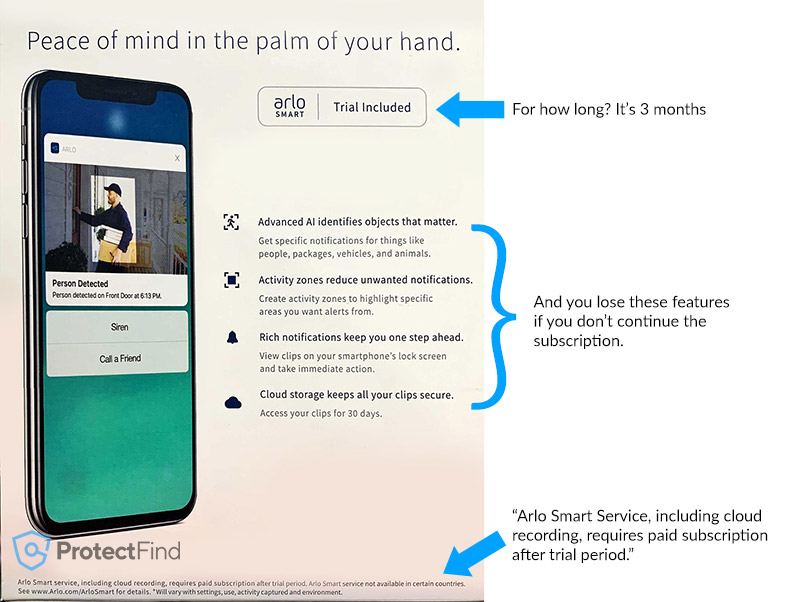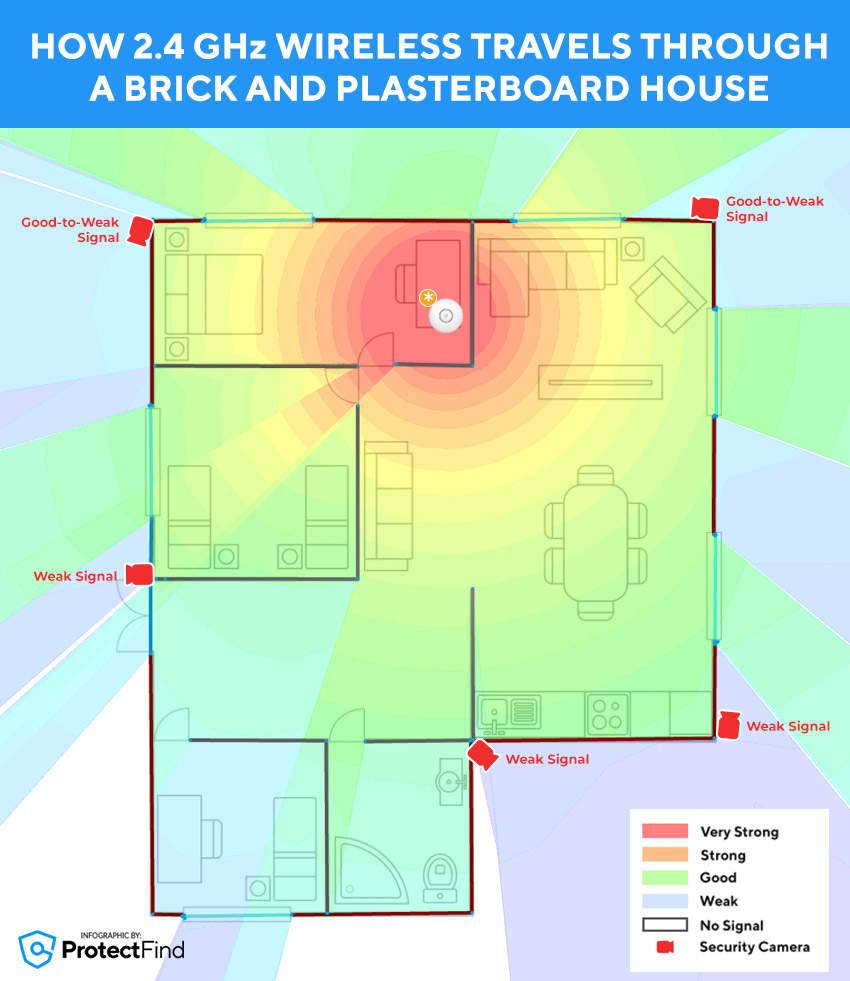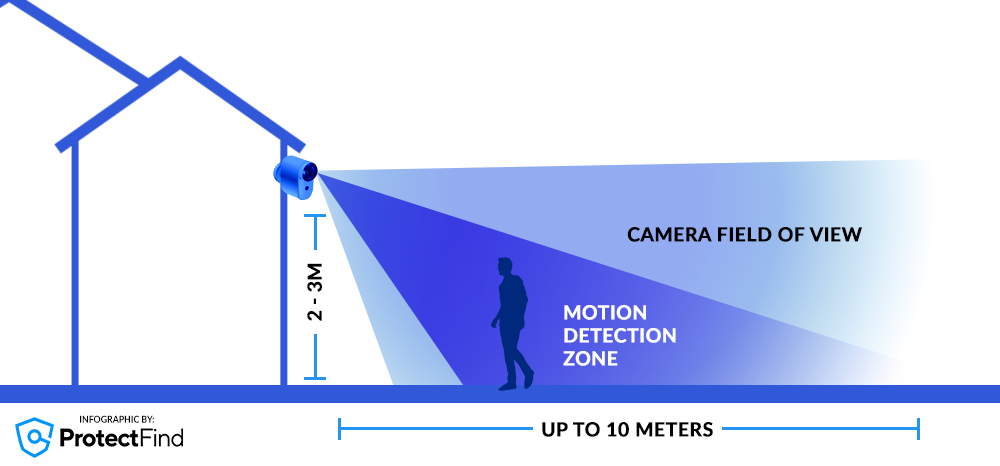While wireless-battery operated cameras are convenient, they come at the cost of many downsides. In this article, I share the rarely talked about issues with wireless battery cameras.
These little security cameras are soaring in popularity. When people hear about burglaries in their neighbourhood, they often rush out to the local hardware or electronics stores and buy these camera systems.
Part of their popularity is people understand them. It’s like buying an appliance. You go in, grab the box off the shelf, pay at the counter and walk out. You can be up and running in an hour or two which is quite appealing.
On the other side, a wired camera setup needs to be planned carefully, and if you are in Australia, it must be installed by a licensed security installer.
So what is wrong with Wireless Battery Operated Cameras?
Monthly Fees
The Existence of Monthly Fees Isn’t Always Obvious
In many cases, it is not always obvious that certain camera kits require a subscription at all. And that if you don’t pay for the subscription, your camera often loses its best features.

In my opinion, I believe manufacturers should make the existence of a subscription more obvious.
The Subscription Price Adds Up
Here is the pricing for one of the most popular brands of wireless battery cameras here in Australia.
| No. of Cameras | Monthly Cost | Yearly Cost | 5 Year Ownership |
|---|---|---|---|
| 1 | $4.49 | $53.88 | $269.40 |
| 2 to 5 | $14.99 | $179.88 | $899.40 |
If you pay for the subscription for five years, it comes to a whopping $900. This is on top of the ~ $900 you have already paid for the hardware, so the total cost of 5-year ownership is $1800.
While a wired system is generally more expensive initially, you can get a far more capable and reliable system installed by a professional for $1800.
They Can Change the Pricing and Features
Perhaps you knew about the subscription and how much it would cost when you purchased the camera kit. The company can still increase the subscription price throughout your ownership, or even worse, change the terms where you could previously use the cameras for free, but then suddenly disable them until you pay for a subscription.

I am not against subscriptions entirely; these companies have to pay real money to cover the cloud hosting costs for millions of their customers.
What I don’t like is that it is not made immediately obvious that the camera even requires a subscription for its best features, and that the terms can change.
Battery Life
The lack of wiring is very convenient, and some brands tout battery charges lasting three months, six months, or even twelve months.
The way they achieve this is the cameras enter a low power mode to preserve battery life.
When they detect infrared radiation from a person or animal, they “wake up” and start recording.
The months of battery life claimed are based on average use. You will see the claimed time between charges with only a few “wake up” events a day. However, if you are in a busy location or something continually wakes up the camera, like passing cars, you will need to charge more frequently.
Areas that are consistently dark will require the camera to use its Infrared light more often, which will consume more battery.
Lithium batteries found in battery-operated cameras will degrade over time. Some models have non-user-replaceable batteries as it ruins their IP rating, while others have replaceable batteries which are usually proprietary.
A weak wireless signal will also consume more battery life because the camera needs to consume more resources to find and maintain the wireless connection.
A lot of people also believe that battery-operated cameras are not vulnerable to power outages. However, most brands record their footage back to a base station, which is connected to mains power and will stop working during a power outage.
Wireless Issues
You may have blazing fast Wi-fi inside your house, but when you go outside, much of that speed will be lost. The materials on the outside of your house are usually thicker than the materials inside your internal walls.
If your cameras have a weak connection, it may result in constant disconnects, blocky streams, and take longer to connect to the camera to view it live.
The picture below is how 2.4Ghz wireless travels through a house with brick external walls and plasterboard internal walls. There is decent coverage inside the house and going out the glass windows. However, anywhere on the other side of a brick wall has a weak signal.

2.4Ghz Isn’t Secure
Most wireless security cameras make use of the 2.4Ghz band. It provides enough bandwidth for the cameras to work, has a longer range, and penetrates walls better than 5Ghz wireless.
However, 2.4Ghz wireless has a flaw where a nearby attacker can disconnect your wireless cameras from your network and disable them. It is incredibly easy to do, and you can do it with a $10 device from eBay.
Most thefts are crimes of opportunity and not planned using devices like this, but the vulnerability exists.
Wide Field of View
Most wireless battery operated cameras have a wide field of view. The benefit of this is that they allow you to see more of an area with fewer cameras.
The downside of this is that the wider field of view you have, the closer a person or number plate needs to be to the camera to be identified.
A wide field of view is not unique to wireless battery cameras. The most common field of view for wired cameras is also a wide 114° to 47° degrees. However, with wired cameras, you often have a choice on what type of lens you want. In many cases, being able to see further is more important than seeing a wider area.
Missed Events
Since these cameras sleep to preserve battery power, they sometimes don’t wake up fast enough to capture the event. They need to detect a human or animal on the PIR sensor, then wake up the camera and start recording. If the event happens too quickly, the object may be out of frame before the recording begins.
The massive downside of “on motion” recording is the camera may never detect the event in the first place. No detection is 100% reliable, even on wired cameras.
That is why you want continuous 24/7 recording. Even if the camera never detects the event, you can seek through the footage to see when it happened. Wireless battery cameras can’t do that because it consumes too much battery.
Detection Range
Many wireless battery cameras use Passive Infrared Detection (PIR) to further preserve battery, similar to what you would see on an outdoor sensor light or an indoor alarm system. It looks for the difference in infrared radiation coming off humans and animals.
The benefit of this is it helps reduce false positives and waking the camera unnecessarily.
The problem is that the PIR detection has a limited distance. Much less than what the camera can see visually.
For most of these cameras, the detection zone goes down at an angle. For the demonstration camera that I use, if you mount it at the recommended 7 to 10 feet high, the motion detection zone is only 10 metres.
While the camera may be able to see much further than that, the PIR won’t detect anyone unless they are within 10 metres.
If you angle the camera on an even lower angle than recommended, the detection zone will be reduced even more.

Different security camera brands have different detection ranges; some can detect from further away than others.
Most wired prosumer and professional cameras will use pixel motion detection, which compares one picture to the next to determine if something moved. The camera will then use its AI to determine if what moved is human or not. The benefit of this is it will detect based on what the camera can “see”, rather than the limited range of the PIR detection.
Physical Security
Wireless battery security cameras need to be convenient to put up and take down so you can easily recharge them, and various manufacturers have created their own solutions.
Some are held on magnetically, which is by far the most convenient but also the least secure. While you can simply pull the camera off its magnet, so can anyone else.
Another popular brand has a large “winged” screw that makes it easy to unscrew with just your fingers. But again, so can anyone else.
The wireless battery camera I use for demonstrations can simply be rotated off its mount.
Or, you can just yank them off their mount with enough force.
Of course, wired cameras can be stolen too, but it is far less convenient because they are not intended to be regularly put up and taken down. In most cases, it requires a torx screwdriver bit to remove the enclosure, and then it needs to be unplugged.
Software
Every now and then the camera manufacturer will release a software update. but those automatic updates aren’t always beneficial. Wireless battery cameras often receive software updates to fix past software bugs and sometimes bring new features. However, they can cause problems too.
I am a member of numerous security camera groups on Facebook. Almost every day, someone posts about how their wireless cameras worked fine until a recent update.
While there are usually ways to rectify it, people aren’t necessarily near their cameras. For example, the cameras are watching over their holiday house a few hours drive away.
Unless you know your way around a network firewall, you cannot opt-out of these automatic updates, so it’s always a moving target.
A Place for Wireless Battery Operated Cameras
There are often strict corporate body rules about what you can permanently install if you live in an apartment, which makes wireless battery operated cameras a good option.
If you are renting, you probably won’t want to invest in hard-wired cabling or may not even be allowed to do so.
If you are a property owner, there are some situations where installing hard-wired cabling may be difficult, like going through concrete or having limited accessibility. These make wireless battery operated cameras an option to consider.
Conclusion
I believe that security cameras are mission-critical and need to be highly reliable. They can’t just work some of the time; they need to work when you need them the most, just like a seatbelt.
You will only have a moment to catch a burglars face, and your setup needs to be working perfectly when or if that time comes.
In terms of reliability, nothing beats a wired setup using a prosumer or professional-level camera with 24/7 continuous recording.
